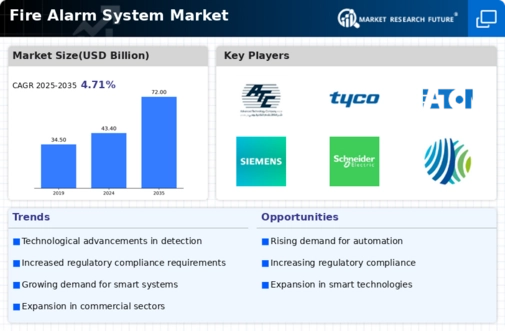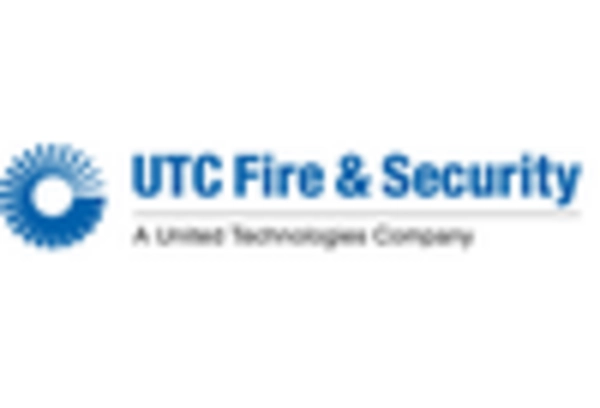Rising Awareness of Fire Safety
The increasing awareness of fire safety among businesses and residential sectors appears to be a pivotal driver for the Fire Alarm System Market. As incidents of fire-related accidents continue to garner media attention, stakeholders are more inclined to invest in advanced fire alarm systems. This heightened awareness is reflected in the growing demand for fire safety training and education programs, which emphasize the importance of reliable fire detection and alarm systems. According to recent data, the fire alarm system market is projected to grow at a compound annual growth rate of approximately 7.5% over the next five years, indicating a robust shift towards prioritizing fire safety measures. Consequently, this trend is likely to bolster the market for fire alarm systems, as organizations seek to mitigate risks and enhance safety protocols.
Growth in Construction Activities
The growth in construction activities across various sectors is likely to serve as a significant driver for the Fire Alarm System Market. As urbanization accelerates and infrastructure projects expand, the demand for fire alarm systems is expected to rise correspondingly. New commercial buildings, residential complexes, and industrial facilities require comprehensive fire safety solutions, including advanced alarm systems. Data suggests that the construction sector is projected to grow at a rate of approximately 5% annually, which will inherently boost the demand for fire alarm systems. Additionally, the trend towards sustainable building practices often incorporates fire safety measures as a fundamental component. This synergy between construction growth and fire safety requirements is anticipated to create a favorable environment for market expansion.
Stringent Building Codes and Regulations
Stringent building codes and regulations are emerging as a critical driver for the Fire Alarm System Market. Governments and regulatory bodies are increasingly mandating the installation of fire alarm systems in both new and existing buildings to enhance public safety. Compliance with these regulations is not merely a legal obligation; it is also a vital aspect of risk management for property owners. The enforcement of these codes is expected to create a substantial demand for fire alarm systems, particularly in commercial and industrial sectors. Recent statistics indicate that regions with stricter fire safety regulations have seen a marked increase in fire alarm system installations, with some areas reporting growth rates exceeding 10% annually. This regulatory landscape is likely to continue shaping the market, as adherence to safety standards becomes paramount.
Technological Advancements in Fire Detection
Technological advancements in fire detection and alarm systems are significantly influencing the Fire Alarm System Market. Innovations such as the integration of IoT devices, smart sensors, and advanced analytics are enhancing the efficiency and reliability of fire alarm systems. These technologies enable real-time monitoring and faster response times, which are crucial in emergency situations. Furthermore, the market is witnessing a shift towards wireless systems, which offer greater flexibility and ease of installation. As per industry estimates, the adoption of smart fire alarm systems is expected to increase by over 30% in the coming years, driven by the demand for more sophisticated safety solutions. This trend not only improves safety outcomes but also presents opportunities for manufacturers to develop cutting-edge products that cater to evolving consumer needs.
Increased Investment in Safety Infrastructure
Increased investment in safety infrastructure is becoming a prominent driver for the Fire Alarm System Market. Organizations are recognizing the importance of safeguarding their assets and personnel, leading to heightened expenditures on fire safety systems. This trend is particularly evident in sectors such as healthcare, education, and hospitality, where the stakes for fire safety are exceptionally high. Recent reports indicate that investments in fire safety infrastructure are expected to rise by approximately 15% over the next few years, as businesses seek to comply with safety regulations and protect their reputations. Furthermore, the integration of fire alarm systems with other safety technologies, such as surveillance and access control, is likely to enhance overall safety strategies. This comprehensive approach to safety infrastructure is expected to drive demand for advanced fire alarm systems.

















Leave a Comment